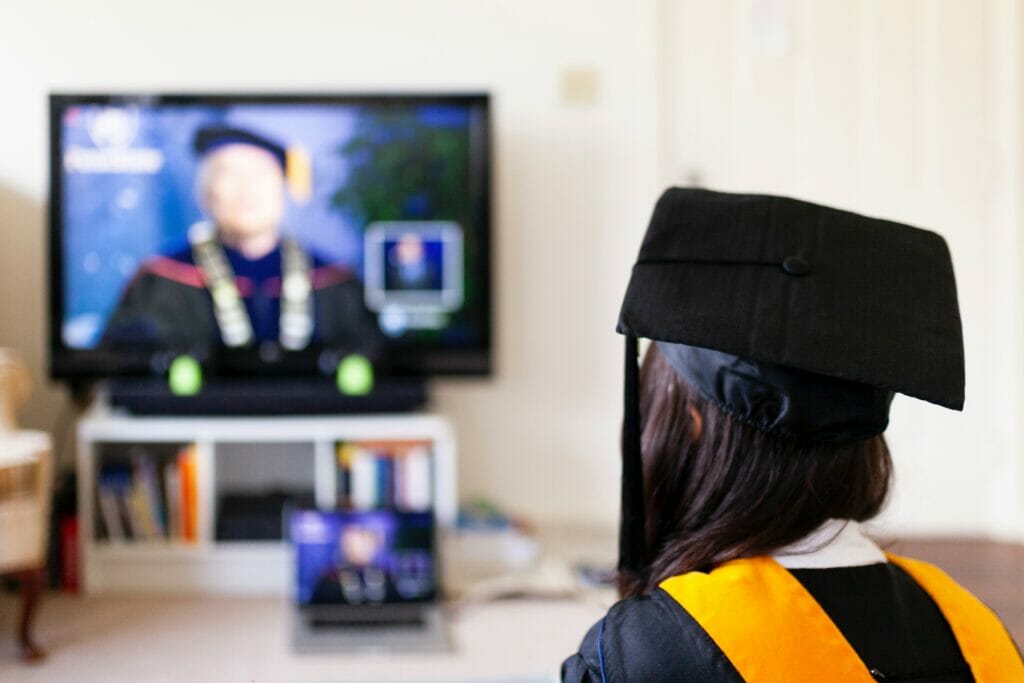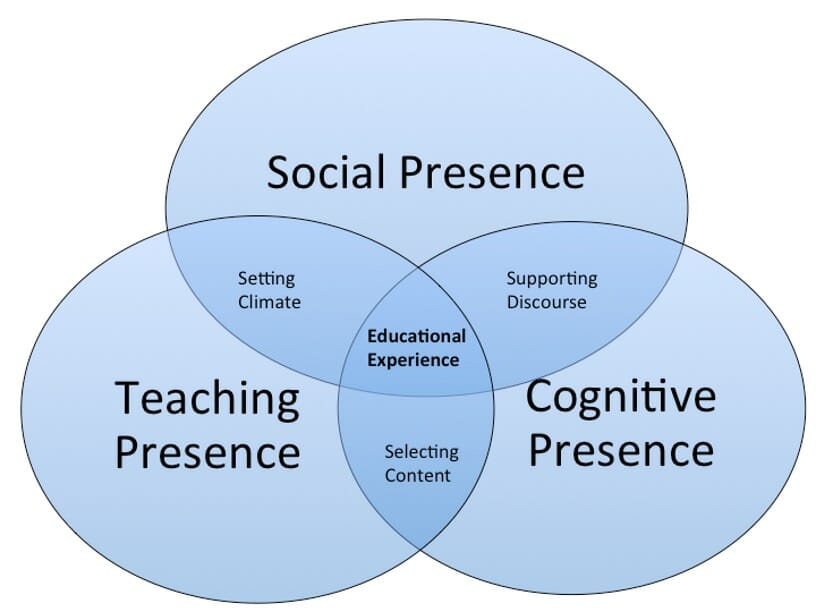The chaos created by the CoVid-19 pandemic on the learning sector means that many learning providers are having to pivot from a delivery model focused on face to face learning interventions to one that relies heavily on virtual learning. Part-time and virtual learning environments were already part of a trend of learners wanting to access their learning activities in ways which fit in with their work and family commitments” (Phillips, 2005: 2). McPherson and Bacow (2015: 138 – 139) claim that “there is a growing interest in ‘blended’ or ‘hybrid’ courses that combine face-to-face instruction with digitized online instruction” and that “a significant growth area for online learning is in professional learning at the graduate level.”
Online tools provide the opportunity for independent, flexible and boundary-less access to learning opportunities. This includes the development modes of flexible and distributed learning, work-based or placement and technology-enhanced learning.
The QAA (2018: 4) describes a distance learner as someone “who:
- has no direct contact with the degree-awarding body, its staff or other learners
- studies their programme with a delivery organisation that is not the degree-awarding body
- receives support for learning from an organisation (support provider) that is neither part of the delivery organisation nor the degree-awarding body.”
The physical location of a learner therefore is no longer relevant, and this means that the current situation requires learning providers to pivot to the provision of learning opportunities and learning design practices that supports a different mode of learning which provides every learner with an equal and effective opportunity to achieve.
The Virtual Learning Environment
Distance Learning is an online delivery method for learning, which raises questions regarding access, andragogy and equity of learner experience. (Foley, 2004) The focus is on an accessible, flexible system providing lifelong learning opportunities, which relies on adults embracing self-directed learning. It is identifiable through the way in which facilitator and learner are separated through the use of technology which in turn provides the platform for the provision of learning materials and ongoing, though likely to be asynchronous, communication (Keegan, 1980; Slyke et al, 2010; Smith, 2010). However, the asynchronous nature of communication in a distance learning mode is considered to be a positive contributing factor with Vonderwell et al (2007: 307) suggesting that it enables groups who are “separated in time and space to engage in the active production of shared knowledge.” This suggests that knowledge, which would otherwise be inaccessible can be accessed by a wider group of individuals enhancing knowledge sharing activities, increasing diversity in ideas and expanding the boundaries of the accessible body of knowledge. Bayne et al (2013) critiques the negative connotations of the reductionism of a spatial construct of absence for distance learners, arguing that learning providers should be viewed as unbounded from the traditional campus viewpoint. Resta and Laferriere (2007: 70) argue that the online environment creates flexibility in both “time and space for cooperative/collaborative learning” to take place, which present new opportunities for learning among a distributed learner population. Distance learning is more than the simple delivery of content via technology but rather a cultivation and blend of social interactivity alongside the sharing of knowledge, feedback, mentoring and experience. Wenger (2004) describes this interaction as learners being provided with the opportunity to engage with one another on current real-world problems they are facing and the approach being taken to tackle them. Since all members of the learner body are “carriers of knowledge” (Wenger, 2004: 5) community knowledge may offer a solution which can be applied to the problem.


Creating a collaborative learning environment using distance learning
Garrison and Kanuka (2004) argue that the complexities of creating an online learning experience, is in part, due to the numerous possibilities in both design and application. What is clear is that creating a learning environment using distance learning is a departure from the pedagogical practices employed by many learning providers. However, McPherson and Bacow (2015) argue that pedagogy is multidimensional rather than specific to mode of delivery. Therefore, it could be argued that the pedagogical changes are simply focused on delivery of ‘good’ learning provision and learning practice rather than something that is online versus traditional.
ChanLin (2012) argues that the development of an individual’s learning strategies are a product of “a learner’s perception of self-efficacy to set goals, maintain motivation and sustain a positive attitude to learning.” It could be argued that creating a virtual learning environment that integrates support for the learner in building a positive perception in these aspects should be incorporated into the course design. The argument that communities of practice are important to the “social fabric of knowledge” is not a new concept. Wenger (2004) outlines how knowing is a group process, a result of the sharing of knowledge in the community as a whole. Possible strategies include clear scheduling of activities to support learner time management of self-directed studies, self-testing for learning and the promotion of a learning community through the development of collaboration, cooperation, dialogue, reflection and active participation could aid learner learning.
Much learning offered online focuses on the delivery of content including the sharing of theories, models, case studies and expertise. Laurillard (2002: 14) argues that situating learning is valuable and that “the acquisition of inert concepts… is no use if the learner cannot apply them.” Pedagogical practices, supported by suitable collaborative learning activities, which offer workplace examples both in content and assessments, provide “unity between problem, context and solution,” (Laurillard, 2002: 16) are required to enable the practitioner to transfer their knowledge to new situations.
Communities of practice
Communities of practice are defined by Wenger (2004: 2) as “groups of people who share a passion for something that they know how to do, and who interact regularly in order to learn how to do it better.” Arguably, collaborative learning activities are an essential element of professional postgraduate learning if core soft skills, such as problem solving, critical thinking and decision-making, are to be developed. Learners can learn together and focus on work related problems, which can increase in work performance and effectiveness as well as develop the community and organisational capability.
The level of learning absorbed by the learner is reliant on the learners’ motivation to learn, their self-efficacy, ability to self-manage and their learning style. However, in contrast to theory, Peters et al (2012: 384) found no “significant relationship between learning and motivation to transfer.” However, there is evidence that learner “satisfaction is important for developing trust in distance learning” (Horvat, et al, 2013: 52). The development of trust can promote deeper learning as peer and support enables scaffolding to occur. Encouraging an environment where both learners and facilitators are active participants and peers in the learning process requires a strong emphasis on regular communication, with a view to developing group cooperation as well as self-directed learning. An important aspect is the creation of a perception of voluntariness in choosing a distance-learning mode. Zamfir (2014) suggests that distance learning offers a personalized approach to learning, which enables learners to work at their own pace. Although this is true to some extent, there is still a structure to the learning because of the requirement to cover a particular syllabus in a set period. However, it can be contested that learners have choice within parameters to direct their own pace of study. Mitchell (2013) suggests that an ideal distance learning learner is one that is focused and self-disciplined, but it could be argued that these characteristics are requirements for all adult learners.
Converting from instructor-Led to learner-centre interventions

Cantrell (2013) advises that creating a new course is most beneficial when converting from an instructor-led to distance learning provision, with a start point of audience, job and task analysis. It is essential that the course designers move away from a concentrating on the theoretical content and become facilitators of cooperative learning. Redpath (2012: 128) highlights the concerns around the “skills and resources” to produce a distance learning environment, as well as issues with a “lack of technical, administrative and financial support.” One issue in developing a distance-learning course is that the research on e-learning is focused on the technology rather than the process of learning, however a Person-Centred e-learning approach seeks to balance the learning process with the content design. Phillips (2005: 6) goes further arguing that, “learning environments should be learner-centred, knowledge-centred, assessment-centred and community-centred.” The emphasis is on a constructivist approach, which promotes deep learning with “a learner-centred approach to teaching; and outcomes-centred subject design” (Phillips, 2005: 6). This approach is supported by Redpath (2012) who emphasises “self-directed discovery and construction of meaning rather than one-way transfer of knowledge from instructor to learner” as a dominant form of online learning. It could be suggested that the opportunity for meaning making is a central pillar of a constructivist approach to higher learning. A distance or blended mode of learning does however rely on learners being autonomous, self-reliant and self-responsible learners.
Technology and learning
Research suggests that technology used in learning “predict a learners’ willingness to use and satisfaction with virtual learning environments” (Eom et al, 2012). Eom et al (2012) cite DeLone and McLean’s (DM) model of information systems success in determining that informational and system quality is a mediating variable of distance learning system use. It could be reasoned that in order to promote high engagement rather than perfunctory use of the systems, good learner experience and reducing the likelihood of learner drop out, it is still important for the course leader to focus on ensuring learners perceive the design and content of the technology adopted for delivery as useful and easy to use as theorized by the Technology Acceptance Model (Eom et al, 2012).
Bayne et al (2013: 4) drawing on the work of Mol and Law (1994) articulate four relational types of spatial orientation experienced by distance learners, arguing that distance learners require “their own version of the certainties of bounded, campus space.” Making a virtual learning environment their campus space provides stable boundaries in which the distance-learner can learn. The inclusion of virtual cafes or green rooms where individuals can congregate outside of schedule learning activity can also improve the location of distance learners in the learning community.
Incorporating distance learning strategies
Distance learning programmes comprise “a myriad of subsystems of human factors, design factors and technological factors” (Eom et al, 2012: 159). It is important to provide an opportunity for learners to cognitively construct an abstract understanding through the acquisition and exploration of theoretical concepts and models. However, theories of pedagogy are dismissive of transmitting information, citing them as ineffective (Dertnl and Motschnig-Pitrik, 2004). Any content shared should be accompanied with activities that encourage action from the learners in the form of questions and activities, plus signposts to further learning materials in order to make the guides “more discursive, by inviting the learner to describe… their conception” (Laurillard, 2002: 95). This provides an opportunity for a social-constructivist approach to knowledge development, in alignment with Vygotsky’s positioning of knowledge as a social construct. However, Foley (2004,191) states “in most cases computer conferencing remains a written/textual, not ‘oral’ practice and therefore many qualities of oral communication and the dynamics of the real seminar room are not present.” Resta and Laferriere (2007: 70) provide another viewpoint, based on research relating to the collaborative nature of online tasks, which can result in “knowledge construction,” the “development of higher order thinking skills,” and “improved productivity.” However, asynchronous conversations can mean that, “the structure of an argument and the key issues can get lost” (Foley, 2004: 192). It could be contended that the ongoing nature of an open discussion forum, over the period of a week means that discussion is not cut off by time restrictions of a traditional classroom environment. Furthermore, it is convenient, and learners and course leaders can return to previous posts to review and reflect on what has been written. Where individuals can get drowned out by more confident or dominant members of the class, online learning spaces offers them a place to voice their ideas and opinions, “confront questionable ideas” (Garrison and Kanuka, 2004: 99) and therefore provides an equal footing which is not based upon the ability to be heard or gender (Horvat et al, 2013). “The fierce debate that can go on in a classroom, the kind that is not personal once the right rapport has been established, may be difficult to reproduce on-line” (Foley, 2004: 194). However, research demonstrates that discussion enables learners to synthesize and integrate ideas necessary for critical thinking (Hazari and Thompson, 2015). Therefore, it is essential that course leaders facilitate inquiry rather than advocacy in the form of an iterative dialogue even if it is asynchronous. This can be achieved through tutors asking Socratic questions to support reflection, precision of expression and eliciting learners to interpret the material being discussed (Laurillard, 2002; Garrison and Kanuka, 2004).
Asynchronous communication systems in the form of online forums can lead to “communication gaps” where confusion can occur (Falloon, 2011: 188 – 189). Moore’s Theory of Transactional Distance argues that cooperation and a learner-centred approach to course structure and the learners’ perception of self-direction and self-determination must be balanced, through the promotion of quality dialogue in order to reduce transactional distance (Falloon, 2011). However, Vonderwell et al (2007) argue that asynchronous online discussion forums provide the opportunity for learners to revisit their contribution to online forums. The addition of live dialogic session would provide the opportunity for face-to-face practical application on real-world tasks and can overcome some of the barriers faced by learners on pure online courses. This provides a solution, which comprises “both interpersonal and technological aspects” (Derntl and Motschnig-Pitrik, 2004: 917) and supports “a greater sense of community” (Falloon, 2011: 205) between the learners and course leaders.
Diminishing transactional distance can be accelerated through the adoption of synchronous technologies to aid real-time dialogue with learners.
Support for distance learners
Course leaders cannot control the cognitive strategies employed by learners to encode information; however, the design of the learning environment can have a positive effect on learner performance by developing “affective strategies to maintain an individual’s emotional status for learning” (Chen and Pedersen, 2012: 364).
Vonderwell et al (2007) argue that distance learning reconstructs the role of the course leader, their practices and the relationship between learner and facilitator. Derntl and Motschnig-Pitrik (2004) state that facilitators should be “highly open, respectful and understanding” helping to raise the learners’ motivation to participate. Redpath (2012: 129) concurs with this perspective stating that “instructor behaviours may be more important than the effects of the discipline taught.” However, the ability of course leaders to facilitate online may be barrier to creating a positive technology-based learning environment (Hazari and Thompson, 2015). It is probable that training will need to be given to develop facilitators of on-line learning and clarifying when, how and how often tutors should intervene in online discussions.
Cooperative learning can be further enhanced by focusing learning activities on bringing together the theoretical to real world applications, through experimentation and skills practice sessions. Garrison and Kanuka (2004) offer a model of Community of Inquiry, (see Figure 1) which “provides the stabilizing, cohesive influence that balances the open communication and dialogue, critical debate, negotiation and agreement – the hallmark of higher learning.”
Very often the design of online learning is focused upon content creation. The Community of Inquiry model places equal emphasis on the development of social presence and teacher (facilitator) presence.
Palmer (1997) highlights integrity and identity as necessary characteristics of a good facilitator, something that is only possible if course leader is “truly present in the classroom and is deeply engaged in the lives of his or her learners” (Pritchard et al, 1998: 37). It is argued that this sense of being present is what Garrison and Kanuka (2004) refer to when discussing tutor presence, that the facilitator becomes a part of the community of the inquiry and a co-learner with the learners are part of the community. Falloon (2011) highlights the contribution such facilitator and learner interaction can have on attitudes to learning, retention, learner performance and the creation of a learning community.
The three connecting elements offered by Garrison and Kanuka (2004) have similarities to Wenger (2004: 3) assertion that there are three elements to a community of practice.
Community of Practice | Community of Inquiry |
Domain What the knowledge the Community is focused upon. | Selecting Content Focused and facilitated learning experiences |
Community Relationship between community members. | Supporting Discourse Sense of community and belonging. Providing meaning to shared ideas |
Practice Body of Knowledge to which the Community contributes to develop their practice | Setting Climate Supporting critical discourse and reflective thinking |
Reviewing the design of a Virtual Learning Environment designed with these ideas in mind will support the “quality and quantity of interaction” (Garrison and Kanuka, 2004: 97) and will ensure that the learners and facilitators can become participants in a community of inquiry. The community will succeed if “members feel they grow every time they meet with the community [and] their personal investment is reinforced and enhanced” (Wenger, 2001: 41).

Recommendations
Based upon the extant literature the following recommendations are made to strengthen the development of distance learning and learning strategies in distance learning:
- Provide training to facilitators on moderating strategies for the asynchronous discussions
- Ensure there is consistency between different facilitators on the design and structure of online content
- Ensure facilitators host regular virtual cafes or online green rooms to provide boundary-less campus space for distance learners.
- Emphasise the need to support the development of community, cooperative and collaborative learning
- Explore the use of Audio visual, video and interactive media to further enhance the online resources provided to learner, developing opportunities of interactivity rather than simple knowledge transmission.
- Provide learners with online ‘tutorials’ and how to guides in regards to rules of engagement.
- Constantly review distance learning practices to capture successful practice and improve design.
Conclusion
The challenge for many learning providers is to deliver a high quality learning, facilitation and learner experience, via distance learning. Although distance learning is primarily labelled as a delivery method, distance learning is also positioned as a cultivation and blend of social interactivity alongside the sharing of knowledge, feedback, mentoring and experience.
A supportive virtual learning environment focuses on indivdiual self-directed learning and the promotion collaboration, cooperation, dialogue, reflection and active participation that could aid individual learning. Collaborative learning activities are an essential element of distance learning for the development of core soft skills.
The ideal distance- learner, like all ideal learners are focused and self-disciplined.
Distance-learning environments should be person-centred, learner-centred, knowledge-centred, assessment-centred and community-centred and construct an opportunity for meaning-making.
Technology offers the opportunity for the creation of a Boundary-less campus, which can use cognitive, social and learning provider presence to develop a Community of Inquiry. However, the most critical element in the creation of successful distance-learning programme is the role of the facilitator. Developing facilitators of learning will be an essential component of success of any distance learning programme.
References
Bayne, S., Gallagher, M. S. and Lamb, J. (2013) Being ‘at’ University: the social typologies of distance students. Higher Education
Cantrell, M. L. (2013) Proposed Process for Analyzing Courses for Comversion From Instructor-Led to Online or Blended Learning. Fire Management Today. Vol. 73, No. 2. Pg. 29 – 34
ChanLin, L. J. (2012) Learning strategies in web-support collaborative project. Innovations in Education and Teaching International. Vol 49, No. 3, pp. 319 – 331
Chen, C. Y. and Pederson, S. (2012) Learners’ internal management of cognitive processing in online learning. Innovations in Education and Teaching International. Vol. 49, No. 4, pp. 363 – 373
Derntl, M. and Motschnig-Pitrik, R. (2004) Patterns of Blended, Person-Centred Learning: Strategy, Concepts, Experiences, and Evaluation. ACM Symposium on Applied Computing pp. 916 – 923
Eom, S., Ashill, N. J., Arbaugh, J. B. and Stapleton, J. L. (2012) The role of information technology in e-learning systems success. Human Systems Management 31 pp. 147 – 163
Falloon, G. (2011) Making the Connection: Moore’s Theory of Transactional Distance and It’s Relevance to the Use of a Virtual Classroom in Postgraduate Online Teacher Education. Journal of Research on Technology in Education. Vol. 43, No. 3 pp. 187 – 209
Foley, G. (2004) Dimensions of Adult Learning: Adult education and training in a global era. Open University Press
Garrison, D. R. and Kanuka, H. (2004) Blended learning: Uncovering its transformative potential in higher education. Internet and Higher Education. Vol. 7 pp. 95 – 105
Hazari, S. and Thompson, S. (2015) Investigating Factors Affecting Group Processes in Virtual Learning Environments. Business and Professional Communication Quarterly. Vol. 78, (1) pp. 33 – 54
Horvat, A., Krsmanovic, M., Dobrota, M. and Cudanov, M. (2013) Students’ Trust in Distance Learning: Changes in Satisfaction and Significance. Management Journal for Theory and Practice Management. 69, pp. 47 -54
Keegan, D. J. (1980) On Defining Distance Education Distance Education 1 (1) 13 – 36
McPherson, M. S. and Bacow, L. S. (2015) Online Higher Education: Beyond the Hype Cycle. Journal of Economic Perspectives. Vol. 39. No. 4 pp. 135 – 154
Mitchell, K. (2013) Learning from a Distance: Online Education Programs Are Undergoing Rapid Change. Business West, March pp. 27 – 37
Palmer, P. (1997) The Courage to Teach. San Francisco: Jossey-Bass
Peters, S., Barbier, M., Faulx, D. and Hansez, I. (2012) Learning and Motivation to transfer after an e-learning programme: impact of trainees’ motivation to train, personal interaction and satisfaction. Innovations in Education and Teaching International Vol. 49, No. 4, Nov. pp. 375 – 387
Phillips, R. (2005) Challenging the Primacy of Lectures: The Dissonance Between Theory and Practice In University Teaching, Journal of University Teaching and Practice, 2 (1) vol. 2, Issue 1, Article 2 pp. 1 – 12
The Quality Assurance Agency for Higher Learning (2018) UK Quality Code for Higher Learning. Part B: Assuring and Enhancing Academic Quality. Chapter B3: Learning and Teaching. Gloucester
Redpath, L. (2012) Confronting the Bias Against On-Line Learning in Management Education, Academy of Management Learning and Education. Vol. 11, No. 1 pp. 125 – 140
Resta, P. and Laferriere, T. (2007) Technology in Support of Collaborative Learning. Education Psychology Review. 19: pp. 65 – 83
Roy, K. (2006) The Impact of Learning Styles on Interactivity in Asynchronous e-Learning. Performance Improvement. Vol. 45, No. 10, pp. 21 – 26
Pritchard, R. J., Massenghi, N., Merritt, S. and Jackl, A. (1998) Book Review – The Courage to Teach. The Quarterly pp. 37 – 40
Smith, C. J. (2010) Distance Learning or Learning at a Distance? Case Study of an education initiative to deliver an in-service bachelors degree in Zambia. Vol. 47, No. 2, pp. 223 – 233
Vonderwell, S., Liang, X. and Alderman, K. (2007) Asynchronous Discussions and Assessment in Online Learning. Journal of Research and Technology in Education, 39 (3), pp. 309 – 328
Wenger, E. (2001) Organically Grown. TD, June pp. 40 – 42
Wenger, E. (2004) Knowledge management as a doughnut: Shaping your knowledge strategy through communities of practice. Ivey Business Journal. January/February pp. 1 – 8
Zamfir, G. (2014) Assisted Learning Systems in e-Education. Informatica Economica, Vol. 18, no. 3 pp. 91 – 102













